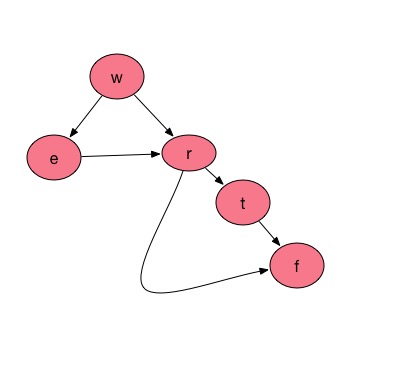There is a new alien language which uses the latin alphabet. However, the order among letters are unknown to you. You receive a list of words from the dictionary, where words are sorted lexicographically by the rules of this new language. Derive the order of letters in this language.
For example,
Given the following words in dictionary,
[
"wrt",
"wrf",
"er",
"ett",
"rftt"
]
The correct order is: "wertf".
Note:
You may assume all letters are in lowercase.
If the order is invalid, return an empty string.
There may be multiple valid order of letters, return any one of them is fine.
Hide Company Tags Google Facebook
Hide Tags Graph Topological Sort
Hide Similar Problems (M) Course Schedule II
提示是topological sort。利用topological sort can find directed acyclic graph's order that’s why this question can be solved by it.
读题后发现,给我们的dictionary 是sorted by lexicographically according to new alien rules.所以第一排的order都在第二排之前。每一排前面的都在后面的之前。
于是可以把每个char看作node,第一步我们要做的就是把每一排connect。比如wrt to wrf, we only need to add a directed path from t to f.
所以利用BFS把node都放进map里,然后计算每个点的indegree, 然后找order。
比如make graph 完我没有了如下的图:
该图的indegree:
code 如下:
class Solution {
public:
string alienOrder(vector<string>& words) {
if(words.size() == 1) return words[0];
graph g = makeGraph(words);
unordered_map<char, int> indegree = computeIndegree(g);
string res;
queue<char> toVisit;
int charNumb = indegree.size();
//find root!
for(auto neigh : indegree) {
if (!neigh.second) {
toVisit.push(neigh.first);
}
}
for(int i = 0; i<charNumb; ++i){
if(toVisit.empty()) return "";// the graph is not connected
char c = toVisit.front();
toVisit.pop();
res += c;
for(auto neigh : g[c]){
if(!--indegree[neigh]) toVisit.push(neigh);
}
}
return res;
}
private:
typedef unordered_map<char, unordered_set<char>> graph;
graph makeGraph(vector<string>& words){
graph g;
size_t n = words.size();
for (int i = 1; i<n; ++i) {
string word1 = words[i-1], word2 = words[i];
size_t l1 = word1.size(), l2 = word2.size();
int l = max(l1, l2);
bool found = false;
for (int j = 0; j < l; ++j) {
if(j < l1 && g.find(word1[j]) == g.end()) g[word1[j]] = unordered_set<char>();
if(j < l2 && g.find(word2[j]) == g.end()) g[word2[j]] = unordered_set<char>();
if(j < l1 && j < l2 && word1[j] != word2[j] && !found){
g[word1[j]].insert(word2[j]);
found = true;
}
}
}
return g;
}
unordered_map<char, int> computeIndegree(graph& gra){
unordered_map<char, int> indegree(gra.size());
for(auto& g : gra){
if(indegree.find(g.first) == indegree.end()) indegree[g.first] = 0;
// if (indegree[g.first] == 0) {};//to make sure that a node with 0 indegree will not be left out.
for(char neigh : g.second) ++indegree[neigh];
}
return indegree;
}
};







 本文介绍了一种基于拓扑排序的方法来解析一种未知外星语言的字母顺序。通过分析已排序的字典条目,我们可以确定字母间的相对顺序。
本文介绍了一种基于拓扑排序的方法来解析一种未知外星语言的字母顺序。通过分析已排序的字典条目,我们可以确定字母间的相对顺序。


















 247
247

 被折叠的 条评论
为什么被折叠?
被折叠的 条评论
为什么被折叠?








